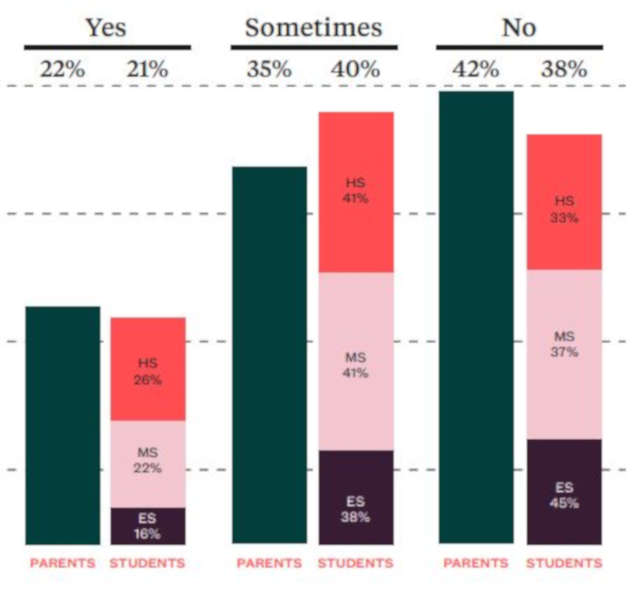Parents and Students Worried about Readiness for School and Work
- By Dian Schaffhauser
- 11/16/20
"Busy
work" was the way most students and parents might classify K-12
instruction last spring, during the first spate of remote education.
In a survey
most students (80 percent) said they had more work to do at least
some days in their remote settings than they had in their traditional
classrooms. However, two-thirds off parents (67 percent), six in 10
students (60 percent) and almost all teachers (94 percent) said that
assignments were either "new and easy" or "something
already learned [or taught]." Students were six times more
likely than teachers to say that assignments were "new and hard"
(40 percent compared to six percent).

This text is intended to be a caption for the above image.
Done
by nonprofit Cognia
the survey took responses from 74,116 people, including students,
parents and teachers from around the world. Most
respondents--58,555--were in the United States. Cognia, based in
Atlanta, focuses on school improvement and accreditation. The
organization's Innovation Lab ran three separate surveys between late
April and late June 2020, to identify how students, parents and
teachers were dealing with the shift to remote learning during the
pandemic. The surveys sought to understand impacts personal, academic
and emotional on each of the groups and on schooling.
Both
parents and students said they were worried that students wouldn't be
fully prepared for the next grade or for college or work. Fifty-seven
percent of parents reported that they were worried at least some of
the time about their children's preparation moving forward. And 61
percent of students said that, "most days" or "some
days", they were worried about not being prepared for the next
year of school. That was less of a concern for elementary students
(54 percent) versus middle schoolers (63 percent) and high schoolers
(67 percent). Yet, teachers weren't as worried. Eighty-two percent
said they were confident that "most of the time" their
instruction was helping students prepare for the coming year.
Seven
in 10 students (71 percent) and eight in 10 parents agreed that
students felt lonely at least some of the time. Two-thirds of
students (68 percent) also reported missing school some or most days.
And nine in 10 students also said that they wished they had said
goodbye to their classmates and teachers.
Likewise,
teachers also reported feeling "disconnected." Most also
said they felt cut off from the workplace and their fellow educators
(99 percent), missed school life (99 percent), missed students and
school events (96 percent) and missed their colleagues (90 percent).
Almost everyone in the teacher role agreed to some extent that they
had to learn new skills (mentioned by 98 percent of teachers) and 42
percent said that teaching remotely "was harder" than they
expected. Seven in 10 said they spent more time preparing their
instructional activities than they did for their face-to-face
classes.
"In
the sudden shift to remote learning environments, everything about
schools--the standard routines, schedules, norms, practices, and
expectations--was upended," said Mark Elgart, president and CEO
of Cognia, in a statement. "Teachers had to adapt their
instruction to a new learning modality, explore entirely new ways of
teaching and scheduling, and be constantly available to address the
social and emotional needs of students and parents. This came at a
cost not only to the tens of thousands of students who could not get
online and are falling further behind, but also to all students who
received a lot of busy work."
He
added that in this current school year the "the first order of
business for schools" was to help teachers address "the
four Rs":
-
Rigor,
by providing more professional development, "to help teachers
adapt to online instruction and set expectations, introduce digital
learning content and tools, redesign instruction and to enable
teachers to spend more time with students without being in their
presence";
-
Routines,
by creating structures for learning and setting expectations,
"putting students in motion towards self-directed learning and
group learning";
-
Relationships,
by emphasizing "peer learning and collaboration among teachers
to help teachers feel connected to school and each other, and to
support improved practice in online learning" and by engaging
students and parents in the learning process and "fostering the
social-emotional well-being of students, parents, and teachers";
and
-
Resources,
making sure that all teachers and students have the technology and
internet connectivity they need for digital learning.
A
summary of key findings is available with registration on
the Cognia website.
About the Author
Dian Schaffhauser is a former senior contributing editor for 1105 Media's education publications THE Journal, Campus Technology and Spaces4Learning.